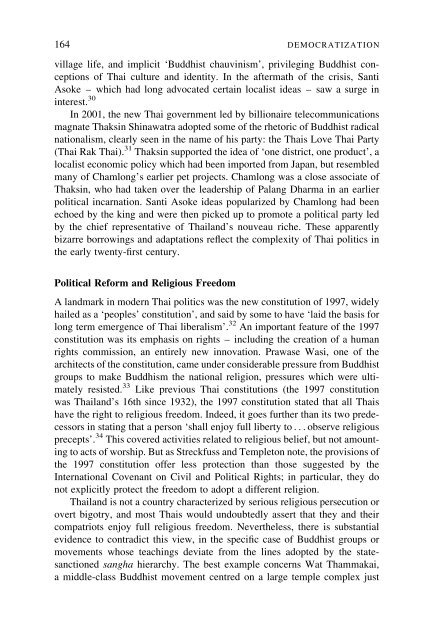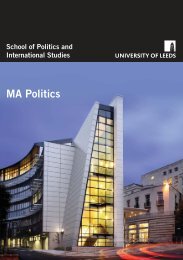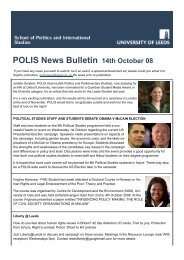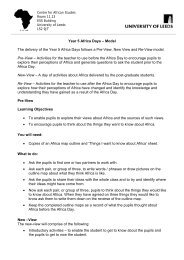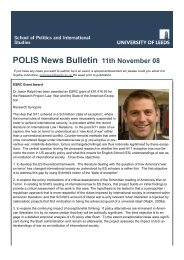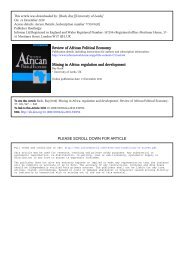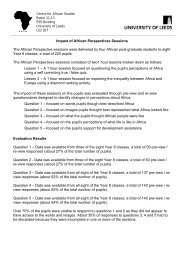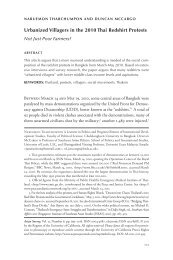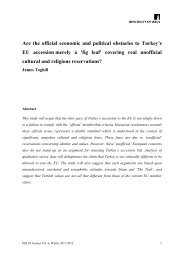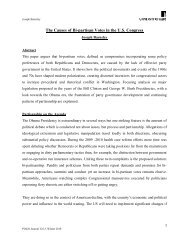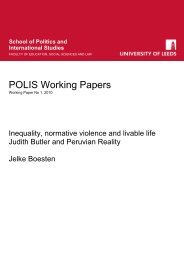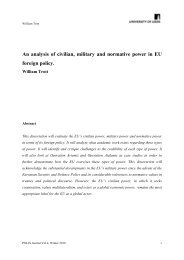164 DEMOCRATIZATIONvillage life, <strong>and</strong> implicit ‘Buddhist chauv<strong>in</strong>ism’, privileg<strong>in</strong>g Buddhist conceptionsof Thai culture <strong>and</strong> identity. In the aftermath of the crisis, SantiAsoke – which had long advocated certa<strong>in</strong> localist ideas – saw a surge <strong>in</strong><strong>in</strong>terest. 30In 2001, the new Thai government led by billionaire telecommunicationsmagnate Thaks<strong>in</strong> Sh<strong>in</strong>awatra adopted some of the rhetoric of Buddhist radicalnationalism, clearly seen <strong>in</strong> the name of his party: the Thais Love Thai Party(Thai Rak Thai). 31 Thaks<strong>in</strong> supported the idea of ‘one district, one product’, alocalist economic policy which had been imported from Japan, but resembledmany of Chamlong’s earlier pet projects. Chamlong was a close associate ofThaks<strong>in</strong>, who had taken over the leadership of Palang Dharma <strong>in</strong> an earlierpolitical <strong>in</strong>carnation. Santi Asoke ideas popularized by Chamlong had beenechoed by the k<strong>in</strong>g <strong>and</strong> were then picked up to promote a political party ledby the chief representative of Thail<strong>and</strong>’s nouveau riche. These apparentlybizarre borrow<strong>in</strong>gs <strong>and</strong> adaptations reflect the complexity of Thai politics <strong>in</strong>the early twenty-first century.Political Reform <strong>and</strong> Religious FreedomA l<strong>and</strong>mark <strong>in</strong> modern Thai politics was the new constitution of 1997, widelyhailed as a ‘peoples’ constitution’, <strong>and</strong> said by some to have ‘laid the basis forlong term emergence of Thai liberalism’. 32 An important feature of the 1997constitution was its emphasis on rights – <strong>in</strong>clud<strong>in</strong>g the creation of a humanrights commission, an entirely new <strong>in</strong>novation. Prawase Wasi, one of thearchitects of the constitution, came under considerable pressure from Buddhistgroups to make <strong>Buddhism</strong> the national religion, pressures which were ultimatelyresisted. 33 Like previous Thai constitutions (the 1997 constitutionwas Thail<strong>and</strong>’s 16th s<strong>in</strong>ce 1932), the 1997 constitution stated that all Thaishave the right to religious freedom. Indeed, it goes further than its two predecessors<strong>in</strong> stat<strong>in</strong>g that a person ‘shall enjoy full liberty to ...observe religiousprecepts’. 34 This covered activities related to religious belief, but not amount<strong>in</strong>gto acts of worship. But as Streckfuss <strong>and</strong> Templeton note, the provisions ofthe 1997 constitution offer less protection than those suggested by theInternational Covenant on Civil <strong>and</strong> Political Rights; <strong>in</strong> particular, they donot explicitly protect the freedom to adopt a different religion.Thail<strong>and</strong> is not a country characterized by serious religious persecution orovert bigotry, <strong>and</strong> most Thais would undoubtedly assert that they <strong>and</strong> theircompatriots enjoy full religious freedom. Nevertheless, there is substantialevidence to contradict this view, <strong>in</strong> the specific case of Buddhist groups ormovements whose teach<strong>in</strong>gs deviate from the l<strong>in</strong>es adopted by the statesanctionedsangha hierarchy. The best example concerns Wat Thammakai,a middle-class Buddhist movement centred on a large temple complex just
BUDDHISM, DEMOCRACY AND IDENTITY IN THAILAND 165north of Bangkok. The movement has long been associated with ambitiousbuild<strong>in</strong>g projects funded by sizeable donations solicited from followers –<strong>in</strong>clud<strong>in</strong>g members of many elite bus<strong>in</strong>ess, bureaucratic <strong>and</strong> political families –<strong>and</strong> for the unorthodox meditation techniques it advocates, promis<strong>in</strong>g a quickway to nirvana. 35 While another heterodox movement, Santi Asoke, wasousted from the orthodox sangha <strong>in</strong> the 1980s, Wat Thammakai flourishedunchecked for much longer, largely ow<strong>in</strong>g to ‘protection’ from wellconnectedsupporters. By 1999, however, Wat Thammakai was <strong>in</strong> disgrace,the abbot charged with various offences concern<strong>in</strong>g illegal l<strong>and</strong> purchases<strong>and</strong> embezzlement. These alleged crimes, however, were overshadowed byan outspoken public denunciation of the movement’s version of <strong>Buddhism</strong>,culm<strong>in</strong>at<strong>in</strong>g <strong>in</strong> the Supreme Sangha Council order<strong>in</strong>g the abbot to renouncehis teach<strong>in</strong>gs, <strong>and</strong> the Religious Affairs Department (part of the M<strong>in</strong>istry ofEducation) charg<strong>in</strong>g Wat Thammakai with ‘propagat<strong>in</strong>g false teach<strong>in</strong>gson Nirvana, caus<strong>in</strong>g divisiveness among monks, <strong>and</strong> spread<strong>in</strong>g hereticdoctr<strong>in</strong>es’. 36 However, as Streckfuss <strong>and</strong> Templeton observe, ‘heresy is nota crime, even <strong>in</strong> Thail<strong>and</strong>’. 37 In other words, there is a schizophrenicconfusion at the heart of Thai th<strong>in</strong>k<strong>in</strong>g about <strong>Buddhism</strong>. On the one h<strong>and</strong>,the constitution guarantees freedom of religion; on the other h<strong>and</strong>, the Thaisangha <strong>and</strong> state believe that, like the medieval Catholic church, theypossess the right to determ<strong>in</strong>e what does <strong>and</strong> does not amount to orthodox<strong>Buddhism</strong>. Under 1969 legislation, the Religious Affairs Department hasthe right to recognize new religious movements under certa<strong>in</strong> clearlydef<strong>in</strong>ed criteria, <strong>in</strong>clud<strong>in</strong>g their be<strong>in</strong>g non-political. For this reason, commentatorssuch as Stewart have suggested that freedom of religion simply does notexist <strong>in</strong> Thail<strong>and</strong>. 38 What is rather surpris<strong>in</strong>g is that despite the popular senseof rights <strong>and</strong> democratic ideas supposedly manifest <strong>in</strong> the 1997 constitutiondraft<strong>in</strong>gprocess, there has been remarkably little public debate aboutfreedom of religion as seen <strong>in</strong> the Wat Thammakai case. Practically no prom<strong>in</strong>entThai scholar or public figure spoke out openly <strong>in</strong> defence of themovement’s freedom to advocate divergent religious ideas; <strong>in</strong>deed, many<strong>in</strong>dividuals widely seen as liberal commentators expressed profoundlyilliberal views on the question of Wat Thammakai, frequently conflat<strong>in</strong>g crim<strong>in</strong>alcharges aga<strong>in</strong>st the abbot with criticisms of the movement’s Buddhistteach<strong>in</strong>gs. Even Santi Asoke, an organization that might be expected tosupport the pr<strong>in</strong>ciple of religious freedom, was quick to condemn WatThammakai. Santi Asoke’s chief adm<strong>in</strong>istrator expla<strong>in</strong>ed that Thammakai’smethods of solicit<strong>in</strong>g donations violated Buddhist doctr<strong>in</strong>es. 39This episode raises difficult questions about the degree to which democraticideas have been firmly <strong>in</strong>stitutionalized <strong>in</strong> the Thai political order.Criticis<strong>in</strong>g the sangha is a problematic act – Matichon, a lead<strong>in</strong>g Thai politicaldaily, had briefly to close itself down <strong>in</strong> 1991, <strong>in</strong> order to atone for hav<strong>in</strong>g


